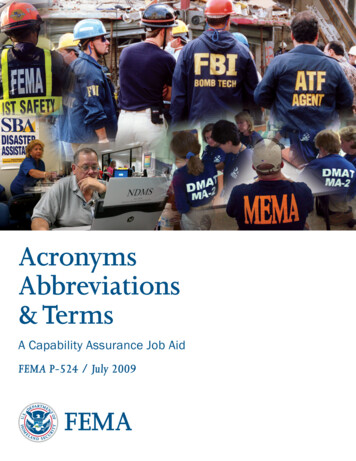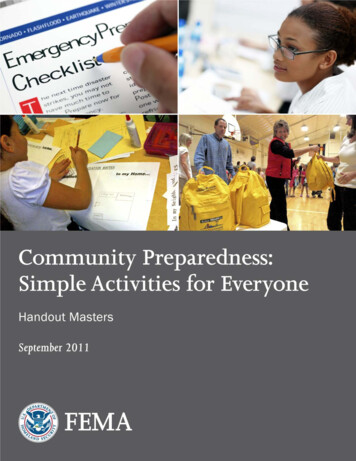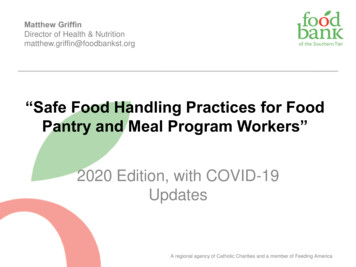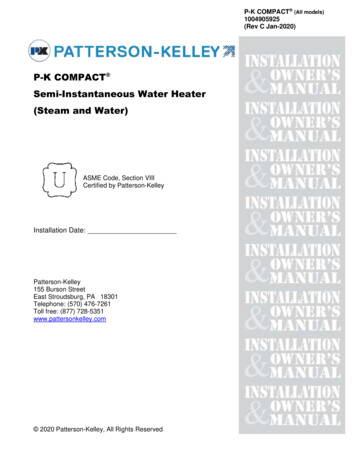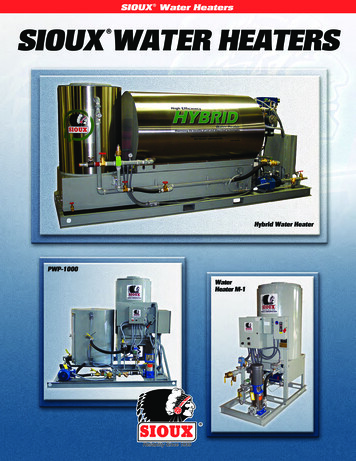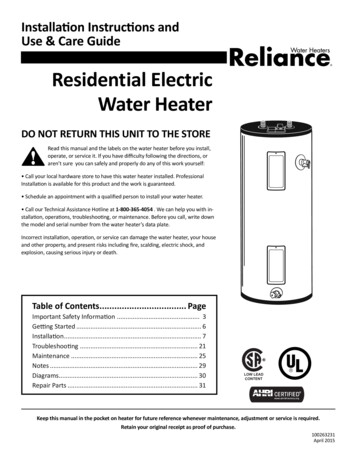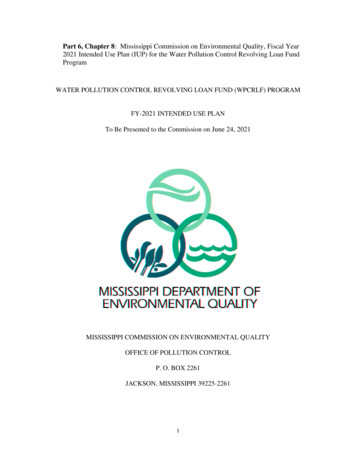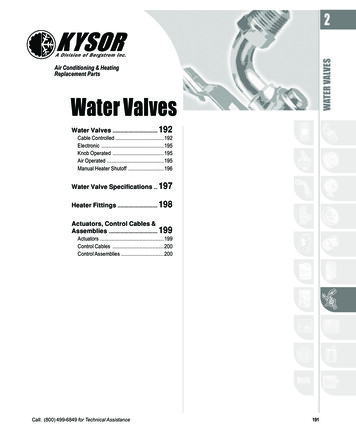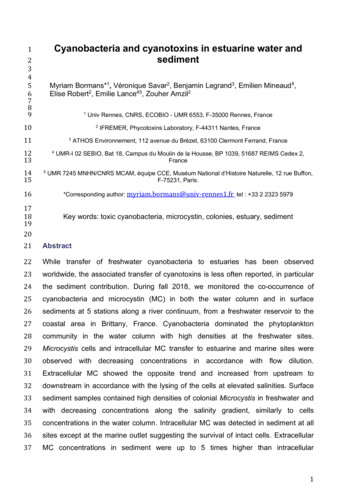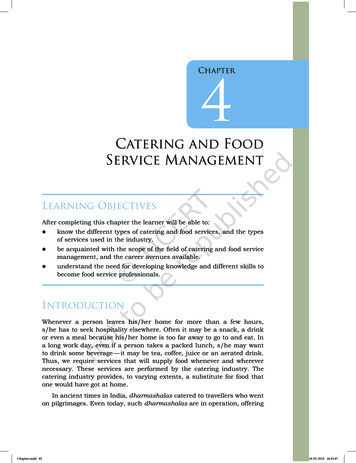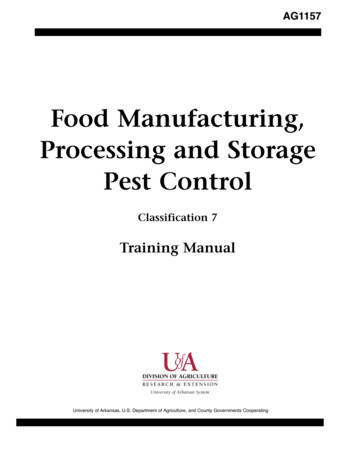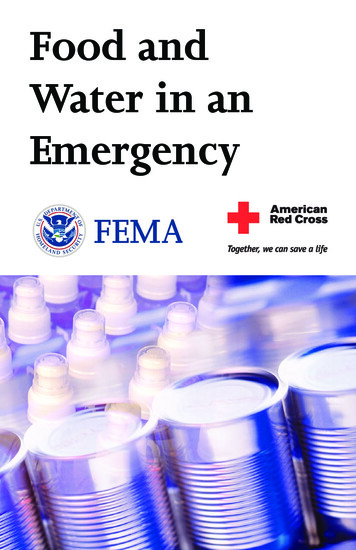
Transcription
Food andWater in anEmergency
If an earthquake, hurricane, winter storm, or otherdisaster strikes your community, you might not haveaccess to food, water, and electricity for days or evenweeks. By taking some time now to store emergencyfood and water supplies, you can provide foryour entire family.
Emergency Food SuppliesEven though it is unlikely that an emergency would cut off yourfood supply for two weeks, consider maintaining a supply that willlast that long.You may not need to go out and buy foods to prepare an emergencyfood supply. You can use the canned goods, dry mixes, and otherstaples on your cupboard shelves. Be sure to check expiration datesand follow the practice of first-in, first-out.PREPARINGANEMERGENCY FOOD SUPPLYAs you stock food, take into account your family’s unique needsand tastes. Familiar foods are important. They lift morale and givea feeling of security in times of stress. Try to include foods that theywill enjoy and that are also high in calories and nutrition. Foodsthat require no refrigeration, water, special preparation, or cookingare best.2
Individuals with special diets and allergies will need particularattention, as will babies, toddlers, and the elderly. Nursing mothersmay need liquid formula, in case they are unable to nurse. Canneddietetic foods, juices, and soups may be helpful for ill or elderlypeople.Make sure you have a manual can opener and disposable utensils.Don’t forget nonperishable foods for your pets.STORAGE TIPS Keep food in a dry, cool spot—a dark area if possible. Open food boxes and other re-sealable containers carefullyso that you can close them tightly after each use. Wrap perishable foods, such as cookies and crackers, inplastic bags and keep them in sealed containers. Empty open packages of sugar, dried fruits, and nuts intoscrew-top jars or air-tight canisters for protection from pests. Inspect all food for signs of spoilage before use. Throw out canned goods that become swollen, dented, orcorroded. Use foods before they go bad, and replace them with freshsupplies, dated with ink or marker. Place new items at theback of the storage area and older ones in front.3
SHELF-LIFEOFFOODSFORSTORAGEThe following provides some general guidelines for replacement ofcommon emergency foods.Use within six months: Powdered milk - boxedDried fruitDry, crisp crackersPotatoesUse within one year, or before the date indicated on the label: Canned condensed meat and vegetable soupsCanned fruits, fruit juices, and vegetablesReady-to-eat cereals and uncooked instant cerealsPeanut butterJellyHard candy and canned nutsVitaminsMay be stored indefinitely (in proper containers and conditions): 4WheatVegetable oilsDried cornBaking powderSoybeansInstant coffee, tea, and cocoaSaltNoncarbonated soft drinksWhite riceBouillon productsDry pastaPowdered milk – in nitrogen-packed cans
IFTHEELECTRICITY GOES OFF . . .FIRST.Use perishable food from the refrigerator, pantry, garden, etc.THEN.Use the foods from the freezer. To limit the number of times youopen the freezer door, post a list of freezer contents on it. In awell-filled, well-insulated freezer, foods will usually still have icecrystals in their centers (meaning foods are safe to eat) for at leasttwo days. Check to make sure the seal on your freezer door is stillin good condition.FINALLY.Begin to use non-perishable foods and staples.5
HOWTOCOOKIF THEPOWER GOES OUTFor emergency cooking indoors, you can use a fireplace. A charcoalgrill or camp stove can be used outdoors. You can keep cookedfood hot by using candle warmers, chafing dishes, and fondue pots.Use only approved devices forwarming food. Canned food canbe eaten right out of the can. Ifyou heat it in the can, be sureto open the can and removethe label before heating. Alwaysmake sure to extinguish openflames before leaving the room.WHEN FOOD SUPPLIESARELOWIf activity is reduced, healthy people can survive on half theirusual food intake for an extended period and without any food formany days. Food, unlike water, may be rationed safely, except forchildren and pregnant women.If your water supply is limited, don’t eat salty foods, since theywill make you thirsty. Instead, eat salt-free crackers, whole graincereals, and canned foods with high liquid content.NUTRITION TIPSDuring and after a disaster, it is vital that you maintain yourstrength. Remember the following: 6Eat at least one well-balanced meal each day.Drink enough liquid to enable your body to function properly(two quarts or a half gallon per day).Take in enough calories to enable you to do any necessary work.Include vitamin, mineral, and protein supplements in yourstockpile to ensure adequate nutrition.
Emergency Water SuppliesHaving an ample supply of clean water is a top priority in anemergency. A normally active person needs to drink at least twoquarts (half gallon) of water each day. People in hot environments,children, nursing mothers, and ill people will require even more.You will also need water for food preparation and hygiene. Storeat least one gallon per person, per day. Consider storing at least atwo-week supply of water for each member of your family. If youare unable to store this quantity, store as much as you can.If supplies run low, never ration water. Drink the amount you needtoday, and try to find more for tomorrow. You can minimize the amountof water your body needs by reducing activity and staying cool.7
PREPAREANDSTOREANEMERGENCY SUPPLYOFWATERTo prepare the safest and most reliable emergency supply ofwater, it is recommended that you purchase commercially bottledwater. Keep bottled water in its original container, and do not openit until you need to use it.Store bottled water in the original sealed container, and observe theexpiration or “use by” date.If You Are Preparing Your Own Containers of Water.It is recommended to purchase food-grade water storage containersfrom surplus or camping supplies stores to use for water storage.If you decide to re-use storage containers, choose two-liter plasticsoft drink bottles – not plastic jugs or cardboard containers thathave had milk or fruit juice in them. The reason is that milkprotein and fruit sugars cannot be adequately removed from thesecontainers and provide an environment for bacterial growth whenwater is stored in them. Cardboard containers leak easily and8
are not designed for long-term storage of liquids. Also, do notuse glass containers, because they are heavy and may break.Preparing Containers Thoroughly clean the bottles with dishwashing soap andwater, and rinse completely so there is no residual soap. Additionally, for plastic soft drink bottles, sanitize thebottles by adding a solution of 1 teaspoon of non-scentedliquid household chlorine bleach to a quart (1/4 gallon) ofwater. Swish the sanitizing solution in the bottle so that ittouches all surfaces. After sanitizing the bottle, thoroughlyrinse out the sanitizing solution with clean water.Filling Water Containers Fill the bottle to the top with regular tap water. (If yourwater utility company treats your tap water with chlorine,you do not need to add anything else to the water to keep itclean.) If the water you are using comes from a well orwater source that is not treated with chlorine, add two dropsof non-scented liquid household chlorine bleach to eachgallon of water. Tightly close the container using the original cap. Becareful not to contaminate the cap by touching the inside ofit with your fingers. Write the date on the outside of thecontainer so that you know when you filled it. Store in acool, dark place. Replace the water every six months if not usingcommercially bottled water.9
HIDDEN WATER SOURCESINYOUR HOMESafe water sources in your home include the water in your hotwater tank, pipes, and ice cubes. You should not use water fromtoilet flush tanks or bowls, radiators, waterbeds, or swimmingpools/spas.You will need to protect the water sources already in your homefrom contamination if you hear reports of broken water or sewagelines, or if local officials advise you of a problem. To shut offincoming water, locate the main valve and turn it to the closedposition. Be sure you and other family members know beforehandhow to perform this important procedure.To use the water in your pipes, let air into the plumbing by turningon the faucet in your home at the highest level. A small amount ofwater will trickle out. Then obtain water from the lowest faucet inthe home.To use the water in your hot-water tank, be sure the electricity orgas is off, and open the drain at the bottom of the tank. Start thewater flowing by turning off the water intake valve at the tank andturning on a hot-water faucet. Refill the tank before turning the gasor electricity back on. If the gas is turned off, a professional will beneeded to turn it back on.EMERGENCY OUTDOOR WATER SOURCESIf you need to find water outside your home, you can use these sources.Be sure to treat the water according to the instructions on the next pagebefore drinking it. Rainwater Streams, rivers, and other moving bodies of water Ponds and lakes Natural springsAvoid water with floating material, an odor, or dark color. Use saltwateronly if you distill it first. You should not drink flood water.10
WAYSTOTREAT WATERThe instructions below are for treating water of uncertain quality inrare emergency situations in the absence of instructions from localauthorities when no other reliable clean water source is availableand you have used all of your stored water. If you store enoughwater in advance, you will not need to treat water using these orother methods.In addition to having a bad odor and taste, contaminated water cancontain microorganisms (germs, bacteria, and viruses) that causediseases such as dysentery, typhoid, and hepatitis. You should treatall water of uncertain quality before using it for drinking, foodpreparation, or hygiene.There are many ways to treat water, though none are perfect. Oftenthe best solution is a combination of methods.Boiling or chlorination will kill most microorganisms but will notremove other contaminants such as heavy metals, salts, and mostother chemicals. Before treating, let any suspended particles settleto the bottom, or strain them through layers of paper towel, cleancloth, or coffee filter.BoilingBoiling is the safest method of treating water. In a large pot or kettle,bring water to a rolling boil for 1 full minute, keeping in mind thatsome water will evaporate. Let the water cool before drinking.Boiled water will taste better if you put oxygen back into it bypouring the water back and forth between two clean containers. Thiswill also improve the taste of stored water.ChlorinationYou can use household liquid bleach to kill microorganisms. Useonly regular household liquid bleach that contains 5.25 to 6.0 percentsodium hypochlorite. Do not use scented bleaches, colorsafe bleaches, orbleaches with added cleaners. Because the potency of bleach diminisheswith time, use bleach from a newly opened or unopened bottle.11
Add 16 drops (1/8 teaspoon) of bleach per gallon of water, stir and letstand for 30 minutes. The water should have a slight bleach odor. If itdoesn’t, then repeat the dosage and let stand another 15 minutes. If it stilldoes not smell of bleach, discard it and find another source of water.Other chemicals, such as iodine or water treatment products (soldin camping or surplus stores) that do not contain 5.25 to 6.0 percentsodium hypochlorite as the only active ingredient, are not recommended and should not be used.DistillationWhile the two methods described above will kill most microorganismsin water, distillation will remove microorganisms that resist thesemethods, as well as heavy metals, salts, and most other chemicals.Distillation involves boiling water and then collecting the vapor thatcondenses back to water. The condensed vapor will not include saltor most other impurities. To distill, fill a pot halfway with water. Tiea cup to the handle on the pot’s lid so that the cup will hang rightside-up when the lid is upside-down (make sure the cup is not dangling into the water), and boil the water for 20 minutes. The waterthat drips from the lid into the cup is distilled. (See illustration.)12
Disaster Supplies KitIn the event you need to evacuate at a moment’s notice and takeessentials with you, you probably will not have the opportunityto shop or search for the supplies you and your family will need.Every household should assemble a disaster supplies kit and keepit up to date.A disaster supplies kit is a collection of basic items a family wouldprobably need to stay safe and be more comfortable during and aftera disaster. Disaster supplies kit items should be stored in a portablecontainer(s) near, or as close as possible to, the exit door. Reviewthe contents of your kit at least once per year or as your familyneeds change. Also, consider having emergency supplies in eachvehicle and at your place of employment.The following should be included in your basic disaster supplies kit: Three-day supply of nonperishable food and manual canopener.Three-day supply of water (one gallon of water per person, perday).Portable, battery-powered radio or television, and extra batteries.Flashlight and extra batteries.First aid kit and manual.Sanitation and hygiene items (hand sanitizer, moist towelettes,and toilet paper).Matches in waterproof container.Whistle.Extra clothing and blankets.Kitchen accessories and cooking utensils.Photocopies of identification and credit cards.Cash and coins.Special needs items such as prescription medications, eyeglasses, contact lens solution, and hearing aid batteries.Items for infants, such as formula, diapers, bottles, andpacifiers.Tools, pet supplies, a map of the local area, and other items to meetyour unique family needs.13
Learn MoreThe Federal Emergency Management Agency’s Community andF
Use the foods from the freezer. To limit the number of times you open the freezer door, post a list of freezer contents on it. In a well-filled, well-insulated freezer, foods will usually still have ice crystals in their centers (meaning foods are safe to eat) for at least two days. Check to make sure the seal on your freezer door is still
